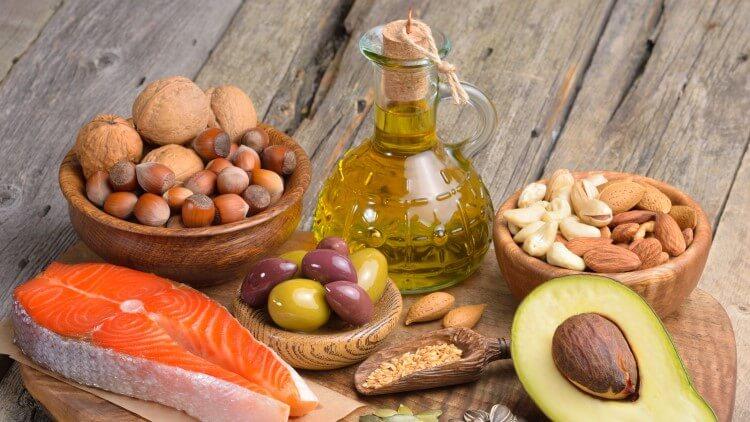
How Much Fat Should You Eat Per Day to Lose Weight
Fat was demonized for many years but it’s now accepted as vital to our health. However, there’s still a hangover belief that low-fat foods will help people lose weight. It can be hugely confusing with so much conflicting information around. Which fats are healthy and which should you avoid? Can you eat it and still lose weight? Precisely how much fat per day should you consume? This article aims to clear up the confusion and walk you through the facts.
- What Is Fat?
- Functions and Benefits of Fat
- Different Types of Fat
- How Much Fat Should I Eat Per Day?
- Healthy Fat Foods You Should Eat
What Is Fat?
Fat is one of the three main macronutrients that we need to survive and thrive. Along with protein and carbohydrates, it supplies the fundamental building blocks that our bodies rely on. Fat is made up of triglycerides which attach together. These triglyceride molecules consist of four parts – three fatty acids and a glycerol backbone. Within the fatty acids are carbon and hydrogen molecules with varying structures. The length of these fatty acids dictates what type of fat it is – short, medium, long, or very long chain. Most dietary fats are long chain although there are some like coconut oil which are rich in medium chain triglycerides (MCT).
Functions and Benefits of Fat
Fat plays a number of roles in the body. It’s crucial to our health and contributes to almost every cell we have. Here’s an overview of the functions and benefits of dietary fat…
- Energy – fat contains 9 calories of energy per gram (over double that of carbs and protein which both contain 4 calories) making it the most potent fuel source of all the macronutrients.
- Vitamin absorption – some vitamins can only be absorbed when fat is present as it acts like a carrier. These include potent antioxidants and essential nutrients like vitamin A, D, E, and K.
- Protection – fat acts as a cushion for your organs and bones against outside impacts as well as insulating your body from the cold.
- Brain function and emotions – fat intake is essential for the health of our brains and regulating mood.
- Hormone production – the production of certain hormones is regulated by fat.
- Satisfaction – our brain is hard-wired to crave fat which means it provides a feeling of satisfaction and fullness after a meal, as well as adding to its flavor.
Although fat has been demonized in the past, it’s now accepted as an essential nutrient for our physical and mental wellbeing.
Different Types of Fat
Fats behave differently based on their structure and composition. Some fats have molecules that are connected with double bonds where as others do not. Although these bonds are tiny, they play a huge role in the behaviour of fats. Depending on the number and location of these bonds, the body will react to and process them slightly differently. It’s these tiny changes that can make the difference between a ‘healthy’ and ‘unhealthy’ fat.
There are four main types of fat that we consume…
- Monounsaturated fats
- Polyunsaturated fats
- Saturated fats
- Trans fats
Let’s look at each of these in a bit more detail.

Monounsaturated Fats
Monounsaturated fatty acids (sometimes shortened to MUFAs) are among the healthiest of all the fats. They contain just one double bond, tend to be fairly stable, and are liquid at room temperature. Olive oil is one of the best sources of these types of fats.
Monounsaturated fats are associated with numerous health benefits. They appear to reduce the risk of heart disease, diabetes, and improve contributing factors like cholesterol balance. Large scale reviews of numerous clinical studies have shown that diets rich in MUFAs decrease weight, along with blood pressure and sugar levels.
Polyunsaturated Fats
Polyunsaturated fats (or PUFAs) have more than one double bond which means they behave slightly differently to MUFAs. They are commonly known as Omega 3 and Omega 6 fatty acids which are beneficial for health when consumed in the right ratios. Omega 3 is associated with reduced inflammation, lower risk of heart disease, and decreased diabetes. Omega 6 also plays a role but can be a source of inflammation when consumed too much. Most people don’t get enough Omega 3 but have too much Omega 6 which leads to a ratio imbalance.
Saturated Fats
Saturated fats don’t contain any double bonds and are thought to be neither positive nor negative for our health. They tend to be stable when cooked – something that can’t be said about PUFAs. Although they were historically linked to higher cholesterol levels, newer research has shown that both ‘good’ and ‘bad’ cholesterol goes up which leads to an overall neutral outcome. Saturated fats can be found in meat and dairy products.
Trans Fats
Trans fats are usually found in processed foods. Although they can be sourced from animal products, the trans fats in modern foods have been chemically modified to behave differently. They have had hydrogen added to them and will sometimes be referred to as ‘partially hydrogenated’ on a food label. These are the ones to avoid wherever possible – you’ll mainly find them in packaged products.
Trans fats are linked to a range of different health issues and have even been banned in some countries. The World Health Organisation has recommended that all governments follow suit due to their negative effects. Their research shows that diets high in trans fats increase heart disease risk by 21% and deaths by 28%.
How Much Fat Should I Eat Per Day?

Most guidance recommends that 20-30% of your energy comes from dietary fat. This means that the actual amount you need will vary based on your calorie requirements. People who are younger, with a larger body mass, or more active lifestyle may need more than others. Use a calorie calculator to work out how much energy you need to consume per day. Then calculate what 30% equates to in calories and divide it by 9. This will give you the number of grams of fat you should be aiming for. For example, if you’re aiming for 2000 calories per day, then 30% is 600. When divided by 9, this equals 66g.
However, if you’re following a set diet then you might want to adapt this accordingly. So, how much fat per day should you eat to lose weight? If you’re restricting your calorie intake, then you can follow the steps above to work out what 20-30% equates to. There’s no need to cut it completely from your diet – it’s entirely possible to eat fat and get thin doing it. Some people even lose weight by following a high fat diet (e.g. keto) but restricting their carbohydrate intake. The key is to find an approach to eating that works for you and doesn’t leave you feeling deprived or hungry.
Healthy Fat Foods You Should Eat
It’s important to choose healthy fats wherever possible. These will deliver multiple benefits whilst also tasting good too. Eating a varied diet will help you to incorporate these foods into your routine. Here are a few of the healthy fat-rich foods you should be eating…
- Nuts – almonds, macadamias, hazelnuts, pecans, peanuts, and pistachios are all good sources of MUFAs.
- Fish – sardines, mackerel, salmon, herring, and anchovies are packed with Omega 3.
- Seeds – chia and flaxseeds are also full of Omega 3.
- Avocados – contain healthy MUFAs.
- Cheese – cheddar and mascarpone are both sources of saturated fat.
- Lean meat – contains MUFAs and saturated fats.
By eating a range of these foods on a regular basis, you’ll supply your body with all the fats it needs to look and feel its best (without gaining weight).
Summary
Fat is not the enemy of weight loss. In fact, it’s absolutely crucial for good health. It’s a source of fuel, aids vitamin absorption, and supports the brain, hormones, and organs. Monounsaturated and polyunsaturated fats are the most beneficial for our health. You can get these from nuts, fish, seeds, avocados, and lean meat. If you’re trying to lose weight, then the exact number of grams of fat you should eat daily will depend on your calorie intake goals. Aim for 20-30% of your total to ensure you enjoy all the health benefits that fat provides.




